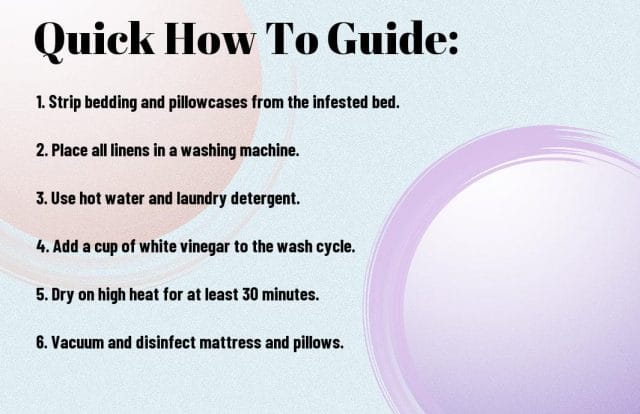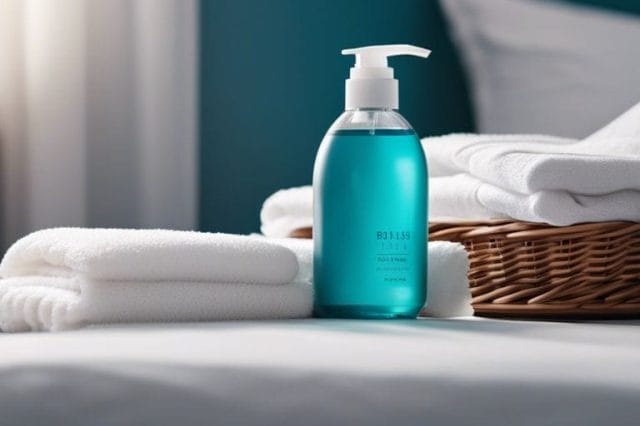Dealing with a lice infestation can be a frustrating and stressful experience, but properly washing your bedding is crucial in eliminating any remaining insects and preventing re-infestation. It’s important to act quickly and thoroughly to remove any potential lice and their eggs from your bedding. Start by stripping your bed of all linens, including sheets, pillowcases, and any blankets or comforters. Wash all items in hot water and dry them on high heat to effectively kill any remaining lice or eggs. Don’t forget to also wash any stuffed animals, decorative pillow covers, and other fabric items that may have come into contact with the affected bedding. Finally, consider using a lice-killing laundry additive to ensure that all pests are fully eradicated. By following these steps, you can rest assured that your bedding is thoroughly clean and free from lice.
Key Takeaways:
- Use hot water: Wash all bedding, including sheets, pillowcases, and blankets, in hot water to kill lice and their eggs.
- Dry on high heat: Dry bedding on high heat for at least 20 minutes to ensure that any remaining lice or eggs are killed.
- Vacuum mattresses and furniture: Use a vacuum with a upholstery attachment to thoroughly clean mattresses, pillows, and furniture to remove any lice or eggs.
- Bag non-washable items: Place non-washable items such as stuffed animals or decorative pillows in a sealed plastic bag for at least two weeks to suffocate any lice or eggs.
- Check for re-infestation: After washing bedding, continue to monitor for signs of lice and take necessary precautions to prevent re-infestation.

Preparing to Wash Your Bedding
Some important steps need to be taken to ensure that all lice and their eggs are effectively removed from your bedding. It’s crucial to prepare your bedding properly before washing to ensure that all lice and their eggs are completely eliminated.
Identifying Bedding Items to Wash
First, go through your bedding and identify all the items that need to be washed. This includes sheets, pillowcases, blankets, comforters, and any other fabric items that have been in contact with the affected person. It’s important to be thorough and make sure that you don’t miss anything that could potentially harbor lice or their eggs.
Gathering Necessary Supplies and Equipment
Before you start washing your bedding, make sure you have all the necessary supplies and equipment. You will need a washing machine, detergent, hot water, and a dryer. It’s important to use hot water as lice and their eggs are killed at temperatures above 130°F (54.4°C). Make sure you have enough detergent to thoroughly clean all the bedding items, and ensure that your dryer is set to a high heat setting to effectively kill any remaining lice and their eggs.
Step-By-Step Washing Guide
Your ultimate goal when washing bedding after dealing with lice is to kill any remaining lice or nits and to prevent re-infestation. Follow this step-by-step guide to properly launder your bedding:
| Step | Instruction |
| 1 | Start by stripping the bed and collecting all bedding items, including sheets, pillowcases, blankets, and mattress covers. |
| 2 | Wash all bedding in hot water (130°F/54°C or higher) to kill lice and nits. Use a heavy-duty laundry detergent. |
| 3 | Dry the bedding on the hottest cycle in the dryer for at least 20 minutes to ensure all lice and nits are killed. |
| 4 | Vacuum the mattress and surrounding area to remove any remaining lice or nits. |
| 5 | Consider using a mattress and pillow encasement to protect against future infestations. |
Stripping the Bed
Before laundering your bedding, it’s crucial to strip the bed completely. This means removing all sheets, pillowcases, blankets, and mattress covers. Make sure to handle the bedding carefully to avoid spreading lice and nits to other areas of the room.
Tips for Washing Various Types of Bedding
When washing different types of bedding, it’s important to consider the best practices for each to ensure lice and nits are eradicated. Here are some tips for washing various types of bedding:
- Sheets: Wash in hot water with heavy-duty detergent to kill lice and nits.
- Pillowcases: Use hot water and a hot dryer cycle to eliminate lice and nits.
- Blankets: Launder in hot water and dry thoroughly to kill any remaining lice or nits.
- Mattress Covers: Wash on the hottest cycle and consider using an encasement for added protection.
- Pillows: Consider replacing pillows, or place them in the dryer on high heat for at least 20 minutes to kill lice and nits.
The key is to ensure all bedding items are thoroughly laundered to eliminate any remaining lice or nits and prevent re-infestation.
Factors to Consider for Effective Lice Elimination
After dealing with lice infestation, there are several factors to consider for effective elimination of lice in your bedding. Here are some key factors to keep in mind:
- Thorough Cleaning: Ensure that your bedding is thoroughly cleaned to remove any lice or nits that may be present.
- Proper Water Temperature: Washing your bedding in hot water can help to effectively kill lice and nits.
- Choice of Detergent: Using a lice-killing detergent or adding a few drops of tea tree oil to your regular detergent can help in eliminating lice.
- Additional Treatment Options: In some cases, it may be necessary to consider additional treatment options to ensure complete elimination of lice from your bedding.
Perceiving these factors can help you in effectively eliminating lice from your bedding and preventing reinfestation.
Water Temperature and Detergent Choices
When washing bedding after dealing with lice, it’s important to consider the water temperature and detergent choices to effectively eliminate lice. Using hot water (at least 130°F) can help to kill lice and nits. In addition, using a lice-killing detergent or adding a few drops of tea tree oil to your regular detergent can aid in effectively removing lice from your bedding.
Drying and Additional Treatment Options
After washing your bedding, it’s essential to thoroughly dry it in high heat as heat also helps to kill lice and nits. Additionally, consider using additional treatment options such as lice-killing sprays or powders to further ensure the elimination of lice.

Additional Tips for Maintaining Lice-Free Bedding
To ensure that your bedding remains free of lice after dealing with an infestation, there are several additional steps you can take. These tips can help to further prevent the spread of lice and keep your bedding clean and safe for you and your family.
- Wash all bedding regularly – To prevent any potential spread of lice, it is important to wash all bedding, including sheets, pillowcases, and blankets, on a regular basis. This will help to remove any lingering lice or nits that may have remained after the initial infestation.
- Use hot water and high heat – When washing your bedding, be sure to use the hottest water temperature and the highest heat setting on your dryer, as this will help to kill any remaining lice or nits that may be present.
- Inspect and vacuum mattresses and pillows – It is important to regularly inspect and vacuum your mattresses and pillows to remove any potential lice or nits that may be hiding in the fabric.
Perceiving the possibility of lice infestations in bedding is crucial, and taking preventive measures can help to maintain a lice-free environment in your home. For more information on whether head lice can live on pillows or sheets, click here.
Regular Bedding Maintenance
After dealing with a lice infestation, it is essential to stay on top of regular bedding maintenance to ensure that your bedding remains free of lice. This includes washing all bedding regularly with hot water and high heat to kill any potential lice or nits that may be present. Additionally, be sure to inspect and vacuum mattresses and pillows to remove any lingering lice or nits.
Preventative Practices to Avoid Future Infestations
To prevent future lice infestations in your bedding, there are several preventative practices you can implement. By regularly washing and inspecting your bedding, using hot water and high heat, and maintaining a clean sleeping environment, you can significantly reduce the risk of future lice infestations. Additionally, educating yourself and your family on lice prevention techniques can help to avoid potential infestations in the future.

How to Wash Bedding After Dealing with Lice
So, now that you’ve dealt with lice, it’s crucial to thoroughly wash all bedding to ensure that the infestation does not return. Start by stripping the bed of all linens and pillowcases, then wash them in hot water and dry on high heat. Additionally, vacuuming the mattress and any upholstered furniture in the room can help to eliminate any lingering lice or eggs. Remember to also wash any stuffed animals or other items in the room that may have come into contact with lice. By taking these steps, you can ensure that your bedding is clean and free of lice, giving you peace of mind and preventing a re-infestation.
FAQ
Q: How should I wash bedding after dealing with lice?
A: After dealing with lice, it is important to wash all bedding, including sheets, pillowcases, and blankets in hot water that is at least 130°F (54°C). This will effectively kill any lice or nits that may be present. It is also recommended to dry the bedding on high heat for at least 20 minutes to ensure that any remaining lice or nits are eliminated.
Q: Can I use regular laundry detergent to wash bedding after dealing with lice?
A: While regular laundry detergent is effective for many types of laundry, when dealing with lice, it is best to use a detergent specifically designed to kill lice and their eggs. Look for products that contain ingredients such as permethrin or pyrethrin, which are known to be effective against lice. Using a lice-specific detergent will help ensure that all lice and nits are completely eradicated from the bedding.
Q: How often should I wash bedding after dealing with lice?
A: It is recommended to wash all bedding, including sheets, pillowcases, and blankets, every two to three days until the lice infestation is completely gone. This regular washing will help to prevent the spread of lice and ensure that any remaining lice or nits are eliminated. In addition to washing the bedding, it is important to also vacuum and clean the surrounding area to remove any lice or nits that may have fallen off the bedding.

